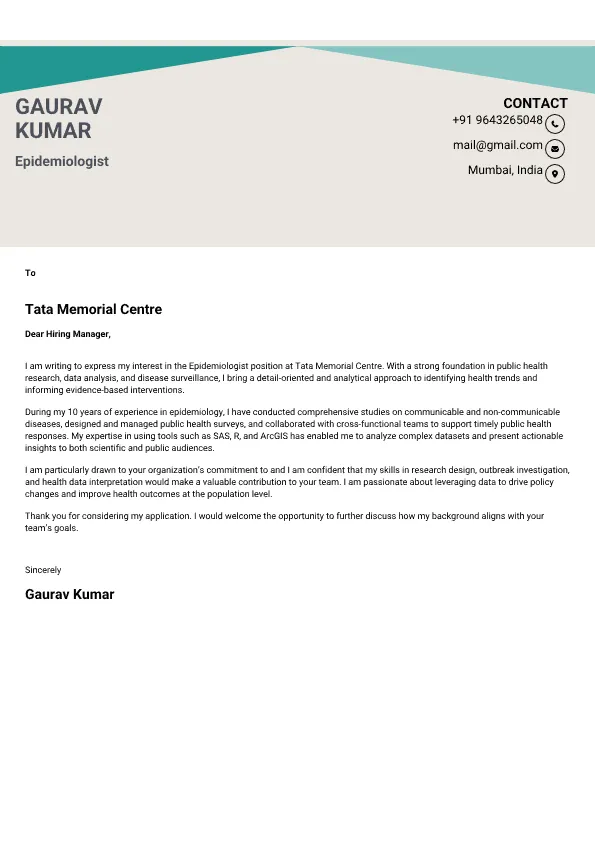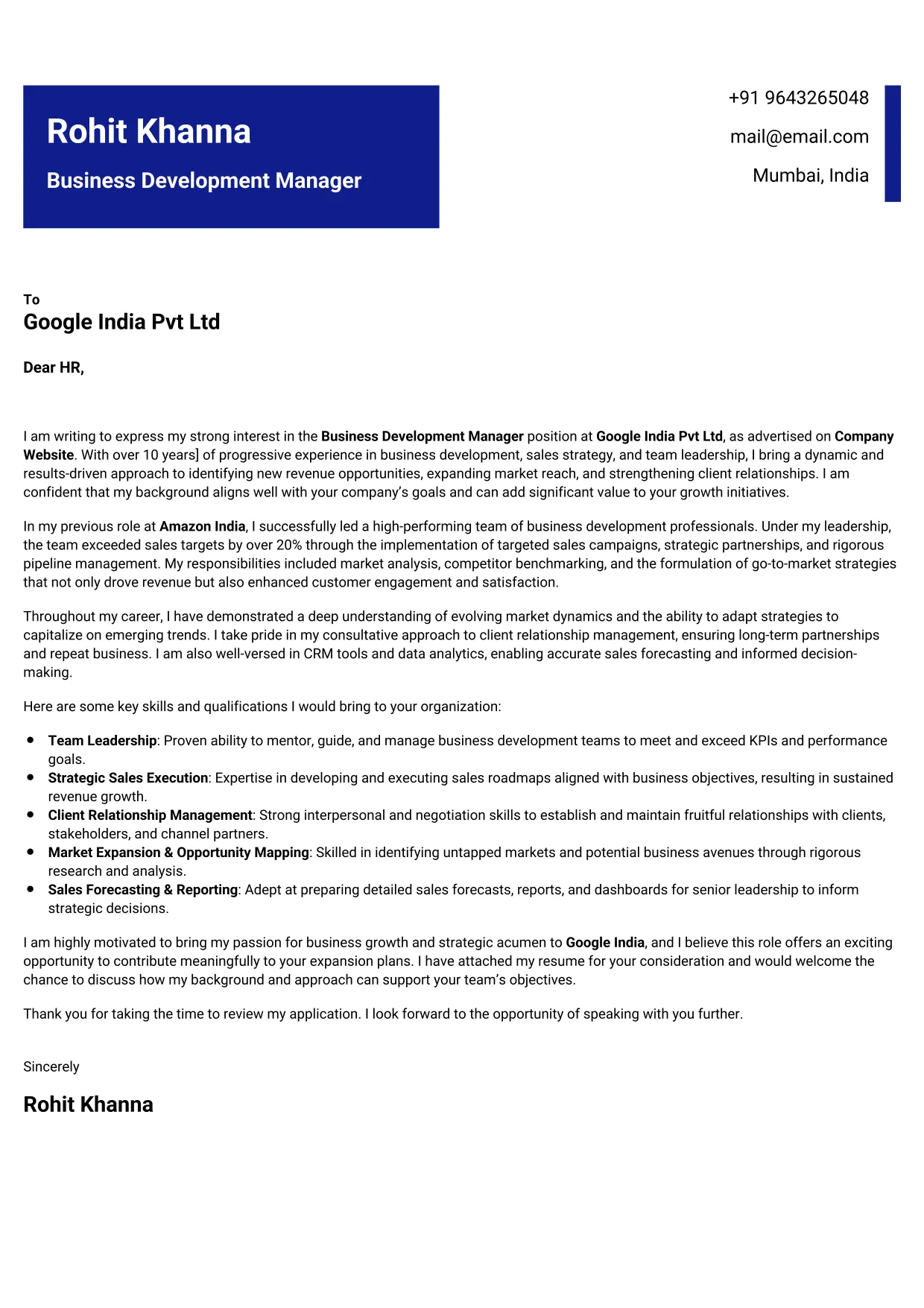Epidemiologist
Welcome to our Epidemiologist cover letter sample page! This professionally designed template is crafted to highlight your expertise in disease surveillance, data analysis, public health intervention, and statistical modeling. Whether you’re pursuing a role in government agencies, research institutions, healthcare systems, or pharmaceutical companies, this sample emphasizes key skills like SAS/R/Python proficiency, epidemiological study design, outbreak investigation, and scientific communication. Tailored to meet 2025 employer expectations, this guide will help you create a compelling cover letter that stands out in the competitive public health and research fields and secures your next impactful career opportunity.

Superbresume.com empowers Epidemiologists to craft cover letters that showcase their analytical rigor and public health impact. Our platform provides customizable templates tailored for research and public health roles, emphasizing expertise in biostatistics, study design, and data interpretation. With ATS-optimized formats, expert-written content suggestions, and real-time feedback, we ensure your cover letter aligns with complex research requirements. Highlight achievements like leading outbreak investigations, publishing peer-reviewed research, or developing effective public health interventions with confidence. Whether you’re a recent MPH graduate or a seasoned public health professional, Superbresume.com helps you create a polished, results-driven cover letter that grabs hiring managers’ attention and lands interviews in vital health organizations.
How to Write a Cover Letter for an Epidemiologist
Craft a Targeted Opening: Write a 2-3 sentence introduction highlighting your expertise in epidemiology, your relevant academic background (e.g., MPH, PhD), and your passion for public health.
Address the Hiring Manager: Use the hiring manager’s name (e.g., “Dear Dr. Gupta”) to personalize the letter and show attention to detail.
Highlight Relevant Experience: Focus on your experience with data collection, statistical analysis, disease surveillance, outbreak investigation, or program evaluation, with specific examples.
Quantify Achievements: Use metrics, e.g., “Analyzed surveillance data for a population of 50,000, identifying a 20% increase in cases,” or “Contributed to a study that reduced disease incidence by 15%.”
Incorporate Keywords: Include terms like “biostatistics,” “study design,” “data visualization,” “R/SAS/Python,” “infectious disease,” or “chronic disease epidemiology” from the job description to pass ATS filters.
Showcase Software Proficiency: Mention your expertise in statistical software and tools like SAS, R, Python, SPSS, Stata, or ArcGIS.
Emphasize Research & Analytical Skills: Highlight your ability to design studies, interpret complex data, and draw valid conclusions.
Demonstrate Communication Skills: Include examples of presenting findings to diverse audiences (scientific, public), writing reports, or publishing research.
Keep It Concise: Limit the cover letter to one page, focusing on your most impactful contributions and analytical capabilities.
Close with Enthusiasm: End with a call to action, e.g., “I’d welcome the opportunity to discuss how my epidemiological expertise can contribute to [Organization Name]'s public health initiatives.”
Geographic Information Systems (GIS): Highlight proficiency in GIS tools (e.g., ArcGIS, QGIS) for mapping disease patterns and environmental factors.
Real-Time Data Analysis: Emphasize experience with real-time or near real-time data analysis for rapid public health response.
One Health Approach: Note understanding or experience with the interconnectedness of human, animal, and environmental health in disease epidemiology.
Digital Health & Syndromic Surveillance: Mention familiarity with using digital health records or social media data for early detection and surveillance.
Communication for Public Impact: Showcase ability to translate complex epidemiological findings into clear, actionable recommendations for policy makers and the public.
Implementation Science: Highlight experience in evaluating the effectiveness of public health interventions in real-world settings.
Ethical Considerations & Data Privacy: Demonstrate strong understanding of data privacy regulations (e.g., GDPR, HIPAA) and ethical conduct in research.
Choose Superbresume.com to craft an Epidemiologist cover letter that truly stands out. Our platform offers tailored templates optimized for ATS, ensuring your expertise in biostatistics, study design, and data analysis shines. With expert guidance, pre-written content, and real-time feedback, we help you highlight achievements like leading outbreak investigations, publishing research, or developing effective public health strategies. Whether you’re a recent graduate aiming for your first role or a seasoned professional seeking a new challenge, our tools make it easy to create a professional, results-focused cover letter. Trust Superbresume.com to showcase your analytical rigor and dedication to public health.
20 Key Skills for an Epidemiologist Cover Letter
| Biostatistics | Epidemiological Study Design |
| Data Analysis (R/SAS/Python) | Disease Surveillance |
| Outbreak Investigation | Statistical Modeling |
| Data Visualization | Scientific Writing |
| Public Health Principles | Research Methodology |
| Grant Writing (Basic) | GIS Software (e.g., ArcGIS) |
| Data Collection & Management | Hypothesis Testing |
| Infectious Disease | Chronic Disease Epidemiology |
| Program Evaluation | Communication (Verbal & Written) |
| Problem-Solving | Ethical Conduct in Research |
10 Do’s for an Epidemiologist Cover Letter
Tailor Your Letter: Customize for each organization, linking your expertise to their specific research areas, public health challenges, or mission.
Highlight Statistical Software: Clearly state your proficiency in tools like R, SAS, Python, SPSS, or Stata.
Quantify Achievements: Include metrics on population size studied, disease reduction percentages, or data points analyzed.
Use Professional & Scientific Language: Employ precise epidemiological and statistical terminology where appropriate.
Showcase Research Experience: Discuss your involvement in study design, data analysis, and dissemination of findings.
Include Publications/Presentations: Mention any peer-reviewed articles, conference presentations, or significant reports.
Optimize for ATS: Use standard formatting and keywords from the job description (e.g., "surveillance data," "risk factors," "population health").
Keep It Professional: Maintain a rigorous, analytical tone and a clean, academic layout.
Mention Relevant Degrees/Certifications: Clearly state your MPH, PhD, or any relevant public health certifications.
Proofread Meticulously: Ensure no typos or grammatical errors, reflecting the precision required in scientific work.
10 Don’ts for an Epidemiologist Cover Letter
Don’t Use Generic Letters: Avoid a one-size-fits-all approach; always personalize for the specific role and organization.
Don’t Overload with Unexplained Jargon: While technical terms are fine, ensure clarity and context for all readers.
Don’t Exceed One Page: Keep it concise and focused on your most impactful epidemiological contributions.
Don’t Skip Metrics: Avoid vague claims; quantify your impact in terms of data analyzed, populations affected, or research outcomes.
Don’t Use Complex Formats: Stick to simple, readable fonts and a clear layout that ATS systems can easily process.
Don’t Omit Data Analysis Skills: Explicitly detail your proficiency with statistical software and analytical techniques.
Don’t Focus Only on Academic Work: Connect your academic experience to real-world public health implications.
Don’t Ignore Communication Skills: Translating complex data for diverse audiences is crucial for epidemiologists.
Don’t Include Irrelevant Experience: Focus solely on epidemiology, public health, or highly quantitative research roles.
Don’t Forget to Update: Regularly refresh your letter to reflect new research, skills, or public health trends.
5 FAQs for an Epidemiologist Cover Letter
Prioritize biostatistics, study design, data analysis (R/SAS/Python), disease surveillance, and scientific communication.
Use standard formatting, avoid graphics, and include keywords like “epidemiological methods,” “public health surveillance,” and “statistical software” from the job description.
You can mention publications or a professional portfolio, stating they are available upon request or on your resume, but avoid direct links within the body of the letter unless explicitly invited.
Mention specific disease areas (e.g., infectious diseases, chronic diseases, maternal health) where you have conducted research or surveillance, linking them to the organization's focus.
Use a professional, precise, and scientifically rigorous tone, conveying your analytical capabilities and dedication to evidence-based public health.
Get 5x more interviews with our crafted Resumes. We make Cover Letter that land jobs.

Free Customized Cover Letter + Expert Resume Advice
Receive a professionally tailored cover letter absolutely free with every resume order—plus expert guidance to make your resume stand out.
